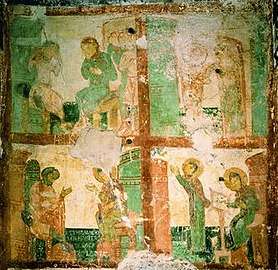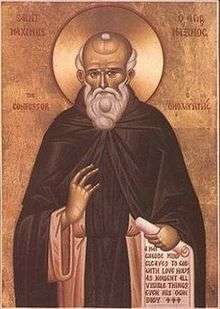February 15 (Eastern Orthodox liturgics)
February 14 - Eastern Orthodox liturgical calendar - February 16
All fixed commemorations below are observed on February 28 by Eastern Orthodox Churches on the Old Calendar.[note 1]
For February 15th, Orthodox Churches on the Old Calendar commemorate the Saints listed on February 2.
Saints
- Apostle Onesimus of the Seventy (c. 109)[1][2][3][4]
- Martyr Major of Gaza (302)[1][3][5]
- Venerable Paphnutius, monk, and his daughter St. Euphrosyne,[6] nun, of Alexandria (5th century)[1][7][8] (see also: September 25)
- Venerable Eusebius, hermit, of Asikha in Syria (5th century)[1][3][9][10][11]
- Saint Theognius, Bishop of Bethelia near Gaza (523)[1][8]
Pre-Schism Western saints
- Saints Faustinus and Jovita, two brothers, belonging to the nobility of Brescia in Italy, zealous preachers of Orthodoxy, beheaded in their native city under Hadrian (2nd century)[12][13][note 2]
- Virgin-martyr Agape, in Terni (Teramo) in Italy (c. 273)[12][14][note 3]
- Martyr Craton and Companions, converted to Christ by St Valentine, Bishop of Terni, martyred in Rome together with his wife and family (c. 273)[12][note 4]
- Martyrs Saturninus, Castulus, Magnus and Lucius, who belonged to the flock of St Valentine, Bishop of Terni in Italy (273)[12][14]
- Saint Dochow (Dochau, Dogwyn), founder of a monastery in Cornwall (c. 473)[12]
- Saint Georgia, a holy virgin and later anchoress near Clermont in Auvergne in France (c. 500)[12][14][15]
- Saint Severus, a priest from the Abruzzi in Italy (c. 530)[12][16][note 5][note 6]
- Saint Quinidius, after living as a hermit in Aix in Provence, he became Bishop of Vaison in France (c. 579)[12][note 7]
- Saint Farannan, Confessor, a disciple of St Columba at Iona in Scotland (c. 590)[12][17][note 8]
- Saint Berach (Barachias, Berachius), disciple of St Kevin and founder of a monastery at Clusin-Coirpte in Connaught (6th century)[12][18][19]
- Saint Faustus, a disciple of St Benedict at Montecassino in Italy (6th century)[12]
- Saint Oswy, King of Northumbria (670)[1][8][20]
- Saint Decorosus, for thirty years Bishop of Capua in Italy, Confessor (695)[12][14]
- Saint Walfrid (Gualfredo) della Gherardesca (765)[12][21][note 9]
- Saints Winaman, Unaman and Sunaman, monks and nephews of St Sigfrid whom they followed to Sweden, martyred by pagans (c. 1040)[12][20]
- Saint Sigfrid of Sweden, a priest and monk, probably at Glastonbury in England, who went to enlighten Sweden, based in Växjö, and converted King Olaf of Sweden (1045)[12][20][22][note 10]
- Saint Druthmar, a monk at Lorsch Abbey, in 1014 he became Abbot of Corvey in Saxony in Germany (1046)[12]
Post-Schism Orthodox saints
- Venerable Paphnutius, recluse of the Kiev Caves Monastery (13th century)[1][8][23]
- Venerable Dalmatius of Siberia, Abbot and founder of the Dormition Monastery (1697)[24][25][26][note 11] (see also: June 10 - Synaxis of All Saints of Siberia)
- New martyr John of Thessaloniki (1776)[27]
- Venerable Anthimos (Vagianos) of Chios (1960)[3][28][29] (see also: February 2)
New martyrs and confessors
- New Hieromartyrs Michael Pyatayev and John Kuminov, Priests of Omsk (1930)[8][26]
- New Hieromartyr Paul (Kozlov), Hieromonk of St. Nilus Hermitage, Tver (1938)[1][8][26][30]
- New Hieromartyrs Nicholas Morkovin,[26] Alexis, and Alexis, Priests; and Simeon, Deacon (1938)[8]
- Virgin-martyr Sophia (1938)[8]
Other commemorations
- Synaxis of the Church of St. John the Theologian at Diaconissa.[1][8][31][note 12]
- Synaxis of the Icon of the Mother of God of Vilnius.[32][33][34]
- Synaxis of Icon of the Mother of God of Dalmatia.[35][36][37][note 13]
- Repose of Blessed Stoina (Euphemia) of Devic Monastery, Serbia (1895)[1]
- Repose of Schema-monk Nikodim of Karoulia (1984)[1]
- Repose of Monk Marcu (Dumitrescu) of Sihastria (ro), Romania (1999)[1]
Icon gallery
.jpg) Martyrdom of Onesimus.
Martyrdom of Onesimus. St. Euphrosyne of Alexandria.
St. Euphrosyne of Alexandria..jpg) Martyrdom of Saints Faustinus and Jovita.
Martyrdom of Saints Faustinus and Jovita. Saint Sigfrid of Sweden.
Saint Sigfrid of Sweden. Venerable Dalmatius of Siberia.
Venerable Dalmatius of Siberia.
Notes
- The notation Old Style or (OS) is sometimes used to indicate a date in the Julian Calendar (which is used by churches on the "Old Calendar").
The notation New Style or (NS), indicates a date in the Revised Julian calendar (which is used by churches on the "New Calendar"). - "AT Brescia, in the time of the emperor Adrian, the birthday of the holy martyrs Faustinus and Jovita, who received the triumphant crown of martyrdom after many glorious combats for the faith of Christ."[14]
- She belonged to a group of virgins formed by St Valentine into a community.
- "At Rome, St. Craton, martyr. A short time after being baptized with his wife and all his household by the holy bishop Valentine, he was put to death with them."[14]
- St Gregory the Great relates that he brought a dead man back to life so that he could receive communion and unction.
- "In the province of Valeria, St. Severus, a priest, of whom St. Gregory says, that by his tears he recalled a dead man to life."[14]
- "At Vaison, in France, St. Quinidius, bishop, whose death was precious in the sight of God, as is shown by frequent miracles."[14]
- Eventually he returned to Ireland to lead the life of a hermit at All-Farannan, now Allernan, in Sligo.
- Born in Pisa in Italy, he married and had five sons and one daughter. In later life he joined two other married men in founding the Monastery of Palazzuolo and a convent nearby for their wives and Walfrid's daughter. Walfrid was the first abbot and was succeeded by one of his sons.
- After Ansgar, epithetised Apostle of the North, Sigfrid is revered as Second Apostle of the North, besides the missionary Rimbert of Turholt.
- Elder Dalmat Isetsky (Dimitry Ivanovich Mokrinskiy). Founder of the Dormition Dolmatovsky Monastery (Dalmatovskoye Monastery), the first Russian settlement in the Urals. Canonized in 1994.
See: (in Russian) Далмат Исетский. - This church was located in Constantinople and is most likely the building presently known as the Kalenderhane Mosque, which has been referred to as St. Mary Diaconissa.
- The Dalmatian Icon of the Dormition of the Most Holy Theotokos is from the Dormition-Dalmatov Monastery in the Province of Perm.
gollark: NOOOO!
gollark: ?coliru```rustfn main() {}```
gollark: Also, what does it do?
gollark: Rewrite in Rust?
gollark: My recursion room brings all the boys to the recursion room.
References
- February 15 / 28. Orthodox Calendar (Pravoslavie.ru).
- Great Synaxaristes: (in Greek) Ὁ Ἅγιος Ὀνήσιμος ὁ Ἀπόστολος μαθητὴς τοῦ Ἀποστόλου Παύλου. 15 Φεβρουαρίου. Μεγασ Συναξαριστησ.
- (in Greek) Συναξαριστής. 15 Φεβρουαρίου. Ecclesia.gr. (H Εκκλησια Τησ Ελλαδοσ).
- Apostle Onesimus of the Seventy. OCA - Lives of the Saints.
- Great Synaxaristes: (in Greek) Ὁ Ἅγιος Μαΐωρ ὁ Μάρτυρας. 15 Φεβρουαρίου. Μεγασ Συναξαριστησ.
- Venerable Euphrosyne of Alexandria. OCA - Lives of the Saints.
- Venerable Paphnutius of Alexandria. OCA - Lives of the Saints.
- February 28 / 15. Holy Trinity Russian Orthodox Church (A parish of the Patriarchate of Moscow).
- Great Synaxaristes: (in Greek) Ὁ Ὅσιος Εὐσέβιος. 15 Φεβρουαρίου. Μεγασ Συναξαριστησ.
- Venerable Eusebius the Hermit of Syria. OCA - Lives of the Saints.
- Rev. Sabine Baring-Gould (M.A.). "S. Eusebius, H. (after A.D. 400.)." In: The Lives of the Saints. Volume the Second: February. London: John C. Nimmo, 1897. p. 306.
- February 15. Latin Saints of the Orthodox Patriarchate of Rome.
- Rev. Sabine Baring-Gould (M.A.). "SS. Faustinus, P., and Jovita, D., MM. (A.D. 120.)." In: The Lives of the Saints. Volume the Second: February. London: John C. Nimmo, 1897. p. 305.
- The Roman Martyrology. Transl. by the Archbishop of Baltimore. Last Edition, According to the Copy Printed at Rome in 1914. Revised Edition, with the Imprimatur of His Eminence Cardinal Gibbons. Baltimore: John Murphy Company, 1916. pp. 48-49.
- Rev. Sabine Baring-Gould (M.A.). "S. Georgia, V. (date uncertain, but probably in the 5th cent.)." In: The Lives of the Saints. Volume the Second: February. London: John C. Nimmo, 1897. p. 306.
- Rev. Sabine Baring-Gould (M.A.). "S. Severus, P. (about A.D. 530.)." In: The Lives of the Saints. Volume the Second: February. London: John C. Nimmo, 1897. pp. 306-307.
- Very Rev. John O'Hanlon. "Article II. — St. Farannan, Confessor, and Patron of All-Farannan, Now Alternan, Parish of Easkey, County of Sligo. [Sixth Century.]." In: Lives of the Irish Saints: With Special Festivals, and the Commemorations of Holy Persons. Vol. II. Dublin, 1875. pp. 552-564.
- Very Rev. John O'Hanlon. "Article I. — St. Berach or Berachius, Abbot, Patron of Kilbarry, County of Roscommon. [Sixth or Seventh century.]." In: Lives of the Irish Saints: With Special Festivals, and the Commemorations of Holy Persons. Vol. II. Dublin, 1875. pp. 534-552.
- Rev. Sabine Baring-Gould (M.A.). "S. Berach, B., Ab. (about A.D. 615.)." In: The Lives of the Saints. Volume the Second: February. London: John C. Nimmo, 1897. pp. 307-309.
- Rev. Richard Stanton. A Menology of England and Wales, or, Brief Memorials of the Ancient British and English Saints Arranged According to the Calendar, Together with the Martyrs of the 16th and 17th Centuries. London: Burns & Oates, 1892. pp. 69-72.
- Rev. Sabine Baring-Gould (M.A.). "S. Walfrid, Ab. of Monte Virido. (about A.D. 765.)." In: The Lives of the Saints. Volume the Second: February. London: John C. Nimmo, 1897. p. 309.
- Rev. Sabine Baring-Gould (M.A.). "S. Sigfried, B. Ap. of Sweden. (about A.D. 1045.)." In: The Lives of the Saints. Volume the Second: February. London: John C. Nimmo, 1897. pp. 310-311.
- Venerable Paphnutius the Recluse of the Kiev Caves. OCA - Lives of the Saints.
- Great Synaxaristes: (in Greek) Ὁ Ὅσιος Δαλμάτιος ὁ ἐκ Σιβηρίας. 15 Φεβρουαρίου. Μεγασ Συναξαριστησ.
- St. Dalmatus, abbot and founder of the Dormition Monastery in Siberia (1697). Holy Trinity Russian Orthodox Church (A parish of the Patriarchate of Moscow).
- The Autonomous Orthodox Metropolia of Western Europe and the Americas. St. Hilarion Calendar of Saints for the year of our Lord 2004. St. Hilarion Press (Austin, TX). p. 15.
- Great Synaxaristes: (in Greek) Ὁ Ἅγιος Ἰωάννης ὁ Νεομάρτυρας ὁ ἐκ Θεσσαλονίκης. 15 Φεβρουαρίου. Μεγασ Συναξαριστησ.
- Great Synaxaristes: (in Greek) Ὁ Ὅσιος Ἄνθιμος ἀπὸ τὴν Χίο. 15 Φεβρουαρίου. Μεγασ Συναξαριστησ.
- St. Anthimus of Chios (1960). Holy Trinity Russian Orthodox Church (A parish of the Patriarchate of Moscow).
- (in Russian) прмч. Павел Козлов (1938). Newmartyros.ru. Retrieved: 03 February, 2015.
- Great Synaxaristes: (in Greek) Σύναξις Ἁγίου Ἀποστόλου καὶ Εὐαγγελιστοῦ Ἰωάννου ἐν τοῖς Διακονίσσης. 15 Φεβρουαρίου. Μεγασ Συναξαριστησ.
- The Vilensk Icon of the Mother of God. Holy Trinity Russian Orthodox Church (A parish of the Patriarchate of Moscow).
- Great Synaxaristes: (in Greek) Σύναξις Ὑπεραγίας Θεοτόκου ἐν Βιλὲνσκ. 15 Φεβρουαρίου. Μεγασ Συναξαριστησ.
- Icon of the Mother of God of Vilnius. OCA - Lives of the Saints.
- "Dalmatian" (1646) Icon of the Mother of God. Holy Trinity Russian Orthodox Church (A parish of the Patriarchate of Moscow).
- Great Synaxaristes: (in Greek) Σύναξις Ὑπεραγίας Θεοτόκου ἐν Δαλματίᾳ. 15 Φεβρουαρίου. Μεγασ Συναξαριστησ.
- Icon of the Mother of God of Dalmatia. OCA - Lives of the Saints.
Sources
- February 15 / 28. Orthodox Calendar (Pravoslavie.ru).
- February 28 / 15. Holy Trinity Russian Orthodox Church (A parish of the Patriarchate of Moscow).
- February 15. OCA - The Lives of the Saints.
- The Autonomous Orthodox Metropolia of Western Europe and the Americas. St. Hilarion Calendar of Saints for the year of our Lord 2004. St. Hilarion Press (Austin, TX). p. 15.
- The Fifteenth Day Day Day of the Month of February. Orthodoxy in China.
- February 15. Latin Saints of the Orthodox Patriarchate of Rome.
- The Roman Martyrology. Transl. by the Archbishop of Baltimore. Last Edition, According to the Copy Printed at Rome in 1914. Revised Edition, with the Imprimatur of His Eminence Cardinal Gibbons. Baltimore: John Murphy Company, 1916. pp. 48-49.
- Rev. Richard Stanton. A Menology of England and Wales, or, Brief Memorials of the Ancient British and English Saints Arranged According to the Calendar, Together with the Martyrs of the 16th and 17th Centuries. London: Burns & Oates, 1892. pp. 69-72.
Greek Sources
- Great Synaxaristes: (in Greek) 15 Φεβρουαρίου. Μεγασ Συναξαριστησ.
- (in Greek) Συναξαριστής. 15 Φεβρουαρίου. Ecclesia.gr. (H Εκκλησια Τησ Ελλαδοσ).
Russian Sources
- (in Russian) 28 февраля (15 февраля). Православная Энциклопедия под редакцией Патриарха Московского и всея Руси Кирилла (электронная версия). (Orthodox Encyclopedia - Pravenc.ru).
This article is issued from Wikipedia. The text is licensed under Creative Commons - Attribution - Sharealike. Additional terms may apply for the media files.

